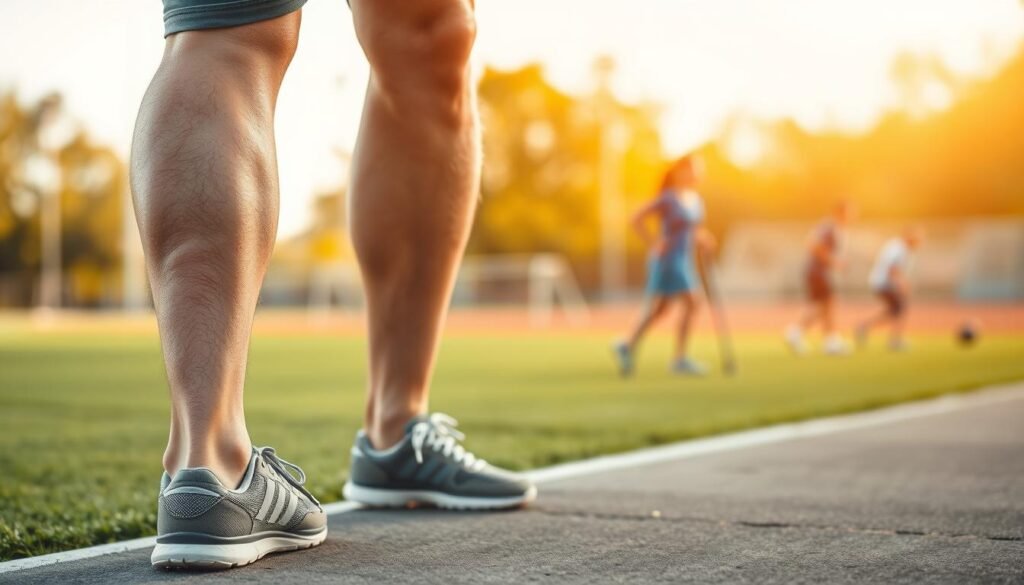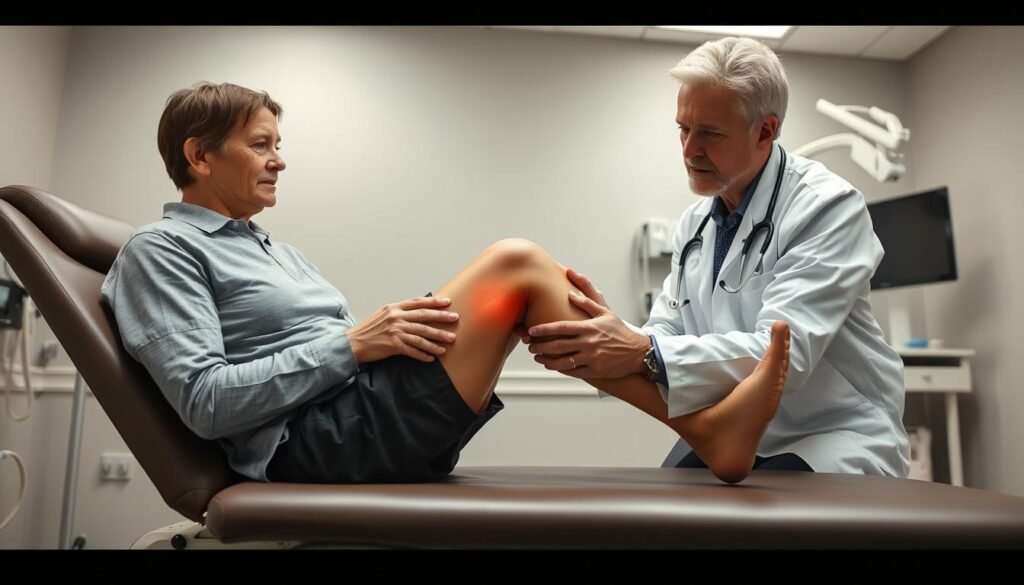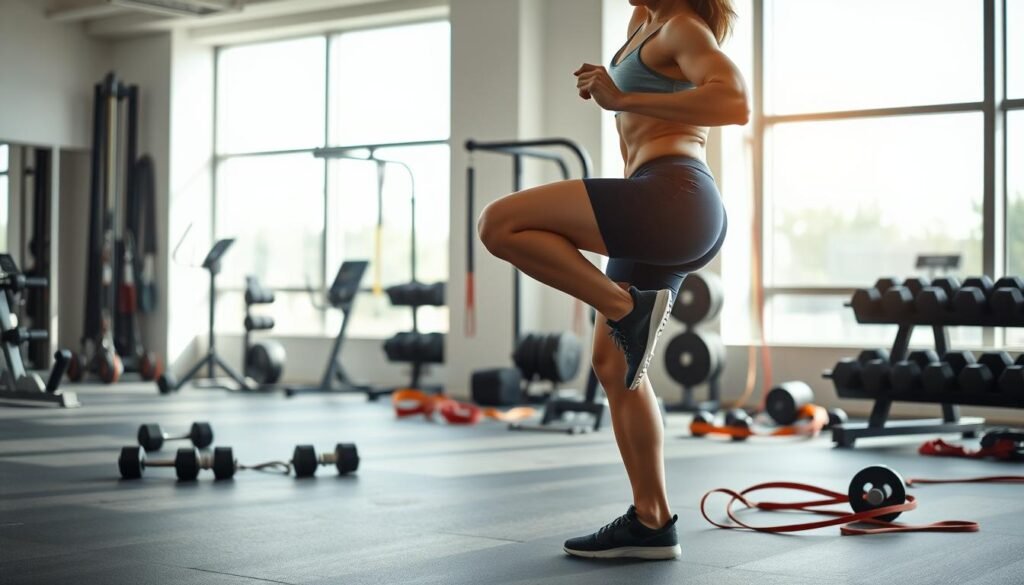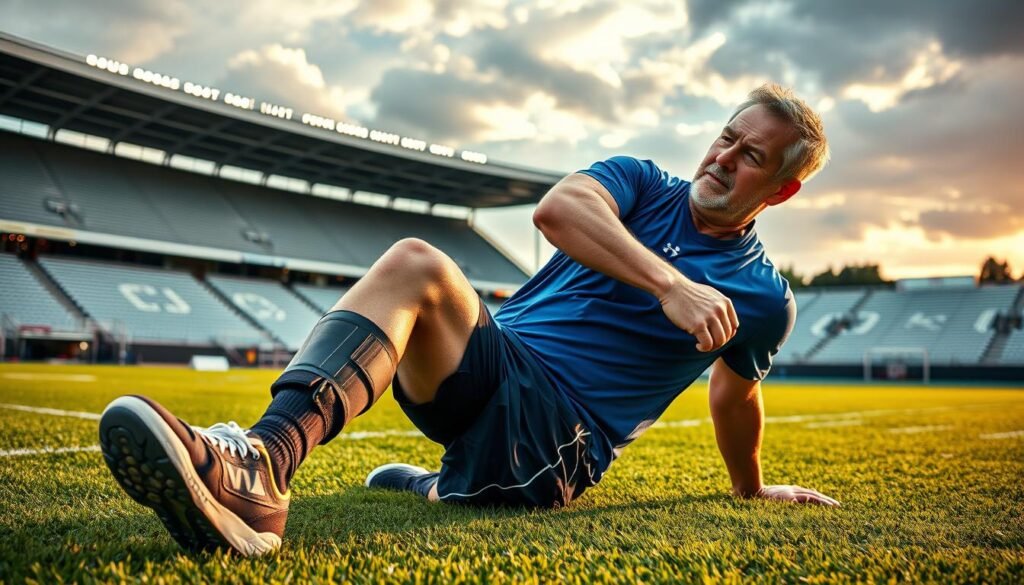
What if the road to reclaiming your athletic potential starts with one critical decision? For athletes facing MCL tears and meniscus damage, this choice often defines their journey back to peak performance. Knee injuries can feel career-ending, but modern rehabilitation strategies offer hope—if approached correctly.
Recovery timelines vary widely depending on injury severity and commitment to treatment. While mild MCL sprains may heal in weeks, complex cases involving cartilage damage often require months of targeted therapy. Research highlights that athletes who prioritize structured physical therapy regain mobility 30% faster than those who rush the process.
We’ve seen how personalized rehab plans reduce reinjury risks. Early phases focus on reducing swelling, while later stages rebuild stability through strength training. Balancing patience with persistence is key—skipping steps risks long-term setbacks.
This article breaks down proven strategies for optimizing knee health post-injury. From initial diagnosis to sport-specific drills, we’ll guide you through rebuilding confidence in your body’s capabilities.
Key Takeaways
- Severity of MCL and meniscus damage directly impacts recovery duration.
- Structured physical therapy accelerates healing by up to 30%.
- Early-stage rehab prioritizes inflammation control and joint protection.
- Gradual strength training minimizes reinjury risks during comeback phases.
- Sport-specific drills restore agility while rebuilding muscle memory.
Understanding MCL and Meniscus Injuries
The knee’s intricate network of ligaments and cartilage acts like a biological shock absorber. Its stability relies heavily on the medial collateral ligament, a band of tissue connecting the thighbone to the shinbone. This structure works with the meniscus—a C-shaped cartilage—to distribute weight and prevent joint grinding.
Anatomy of the Knee and Ligament Function
Located on the inner side of the joint, the medial collateral ligament resists forces pushing the knee outward. It anchors to bony protrusions on the femur and tibia, creating a stabilizing “chain” during lateral movements. When paired with the meniscus, this collateral ligament system ensures smooth rotation and impact absorption.
Common Mechanisms of Injury
Nearly 40% of mcl injuries occur in contact sports like football from direct blows to the knee’s outer side. Non-contact tears often happen during sudden twists or pivots—think basketball players landing awkwardly. Repetitive stress from activities like long-distance running can also weaken these tissues over time.
Research shows 15% of knee injuries involve both ligament and cartilage damage. Understanding these risks helps athletes recognize early warning signs, like swelling or instability. Proper diagnosis matters because untreated mcl injury cases may lead to chronic joint issues.
The Basics of a Safe and Effective Recovery
A structured recovery plan transforms uncertainty into measurable progress. Conservative approaches prioritize gradual healing through phases tailored to tissue response. Research shows 68% of athletes regain full function without surgery when following research-backed rehabilitation protocols.
Early-stage treatment focuses on reducing inflammation while protecting joint integrity. Therapists design programs combining low-impact exercise with manual therapy to restore mobility. Balance drills and resistance bands often anchor initial phases, rebuilding stability without strain.
Timelines fluctuate based on ligament involvement and pre-injury fitness levels. Mild MCL strains may resolve in 4-6 weeks, while complex cases demand 3+ months. Consistency matters—skipping sessions increases reinjury risks by 40%.
We emphasize adherence to phased guidelines. Rushing into high-intensity drills undermines progress, even if pain subsides. Controlled movements like step-ups or wall slides reinforce muscle memory safely.
Optimal physical therapy blends activity with strategic rest. Alternating strengthening days with recovery periods allows tissues to adapt. This rhythm prevents overload while accelerating functional gains.
Evaluating Your Injury: When to Seek Professional Guidance
Recognizing when to seek expert evaluation separates temporary setbacks from lasting recovery. Knee trauma often masks underlying damage, making self-assessment unreliable. Three key indicators demand clinical attention: persistent swelling, joint instability, and sharp pain during weight-bearing activities.

Red Flags Requiring Immediate Action
Ignoring warning signs risks permanent joint deterioration. Athletes frequently mistake mild discomfort for normal soreness, but these symptoms suggest deeper issues:
- Locking or catching sensations during movement
- Difficulty straightening the leg fully
- Sudden weakness when pivoting or descending stairs
Orthopedic specialists use stress X-rays to measure ligament laxity, while MRIs reveal cartilage damage invisible on standard scans. A 2023 Johns Hopkins study found 62% of initially undiagnosed mcl injuries progressed to chronic instability without proper imaging.
Physical therapists perform functional assessments to gauge readiness for activity. They test balance, strength asymmetries, and pain thresholds during sport-specific motions. Early intervention cuts rehabilitation timelines by 22% compared to delayed treatment plans.
We prioritize collaborative diagnostics—combining clinical exams with advanced imaging—to create accurate recovery roadmaps. Waiting for symptoms to “improve on their own” often worsens tissue damage and extends downtime.
Setting Realistic Goals for Our Return to Sport
How do elite athletes bridge the gap between injury and peak performance? Structured goal-setting transforms rehab from guesswork into measurable progress. We prioritize benchmarks validated by NCAA return-to-play protocols, ensuring each phase builds toward sustainable success.
Short-Term Milestones
Initial phases focus on foundational metrics. Pain-free walking and 90-degree knee flexion often mark early wins. Weekly strength tests using pressure plates help quantify improvements in stability.
Sample 4-week targets include:
- 25% reduction in swelling
- Ability to perform single-leg stands for 30 seconds
- 80% weight-bearing capacity
Long-Term Performance Objectives
Advanced stages emphasize sport-specific demands. Soccer players might target 90-degree cutting maneuvers, while basketball athletes prioritize vertical jump recovery. We align these ambitions with timeline checkpoints to prevent overexertion.
| Timeframe | Objective | Success Metric |
|---|---|---|
| 3 Months | Full range of motion | Equal bilateral flexibility |
| 6 Months | Sport-specific agility | 85% pre-injury drill times |
| 9 Months | Competitive readiness | Medical clearance + coach approval |
Data-driven targets keep motivation high while respecting biological healing time. Regular assessments adjust these goals based on individual progress, creating adaptive pathways to competition.
Developing a Personalized Rehabilitation Program
Every athlete’s body responds differently to knee trauma—that’s why cookie-cutter rehab plans fail. Our team builds programs around three pillars: injury specifics, sport demands, and progress metrics. Research from Massachusetts General Hospital shows customized physical therapy protocols improve outcomes by 37% compared to generic approaches.
We start by analyzing movement patterns affected by mcl injury. A soccer player might focus on lateral agility drills, while a runner prioritizes gait retraining. Initial exercises often include seated leg raises and balance board work, progressing to weighted step-ups as stability improves.
Weekly assessments guide adjustments. Therapists measure:
- Range of motion improvements
- Strength symmetry between legs
- Pain levels during functional movements
These checkpoints prevent plateaus and reduce reinjury risks. A 2024 study found athletes using adaptive rehabilitation plans returned to competition 19% faster than those following static routines.
Our phased system evolves with your recovery. Early stages emphasize protection, while later phases incorporate sport-specific drills like box jumps or cutting maneuvers. This tailored strategy ensures your comeback matches your body’s readiness—not arbitrary timelines.
Non-Surgical Treatment Options and Physical Therapy
Conservative approaches prove effective for most knee ligament cases. Studies show 83% of mcl injuries heal without surgery when addressed early. These methods prioritize tissue preservation while restoring functional capacity through guided protocols.
Why Bracing Accelerates Healing
Custom-fitted braces limit sideways knee motion by 40-60%, protecting damaged ligaments during daily activities. This controlled support allows gradual reintroduction of movement while preventing reinjury. Research confirms athletes using stabilization devices during physical therapy regain full mobility 18 days faster on average.
| Recovery Phase | Bracing Benefit | Typical Duration |
|---|---|---|
| Acute (Weeks 1-3) | Reduces swelling | 20-23 days |
| Subacute (Weeks 4-6) | Enables partial weight-bearing | 14-18 days |
| Functional (Weeks 7+) | Supports dynamic movements | Until medical clearance |
Three essential strategies optimize non-surgical treatment:
- Progressive exercises like wall slides and resistance band walks
- Biweekly strength assessments to track quadriceps recovery
- Activity modification based on pain response thresholds
A 2022 Journal of Orthopaedic Research study found structured physical therapy programs reduce chronic instability risks by 67%. We combine bracing with targeted muscle activation drills to rebuild proprioception—your knee’s internal “GPS” for safe movement patterns.
Surgical Intervention: When It’s Necessary
Deciding between surgery and conservative care requires understanding your knee’s structural needs. Grade III MCL tears involving complete ligament rupture often demand operative solutions—especially when combined with meniscus damage. Our team evaluates joint stability through stress tests and MRI findings to guide treatment management decisions.
Comparing Operative and Conservative Approaches
Not all collateral ligament injuries need the operating room. We reserve surgery for cases where:
- Multiple ligaments are torn
- Bone fragments threaten joint function
- Non-surgical methods fail after 3 months
| Approach | Best For | Recovery Time | Success Rate |
|---|---|---|---|
| Surgery | Grade III tears, unstable joints | 4-6 months | 89% full recovery |
| Conservative | Grade I-II tears, isolated injuries | 2-4 months | 78% full recovery |
Modern surgery techniques like arthroscopic repair minimize tissue damage. Patients typically start weight-bearing exercises within 6 weeks post-operation. A 2023 study found athletes undergoing timely procedures regained cutting ability 33% faster than those delaying intervention.
We balance risks like infection against benefits like restored stability. Shared decision-making ensures your treatment aligns with athletic goals and biological readiness. Whether stitching torn fibers or reconstructing ligaments, personalized plans drive optimal outcomes.
Exercises to Regain Range of Motion
Regaining full joint mobility demands precision-guided movements that respect tissue healing timelines. We prioritize low-impact exercises initially, progressing only when stability improves. Controlled motion drills rebuild confidence while protecting vulnerable ligaments.
Foundational Mobility Protocols
Early-stage workouts focus on restoring basic flexion without strain. Seated heel slides using a towel under the foot create smooth gliding motions. Perform 2 sets of 10 repetitions daily, stopping if pain exceeds 3/10 intensity.
Key starter exercises include:
- Prone hangs to passively extend the joint
- Wall-assisted mini squats (30° bend)
- Stationary bike sessions with zero resistance
Dynamic Movement Progressions
Advanced phases introduce multi-directional challenges once 75% range motion returns. Lateral step-overs on 4-inch platforms train rotational control. Therapists often prescribe 3-week blocks with incremental difficulty adjustments.
| Exercise | Purpose | Frequency |
|---|---|---|
| Box step-ups | Rebuilds quad strength | 3x weekly |
| Foam roll balance | Enhances proprioception | Daily |
| Controlled lunges | Restores functional mobility | Every other day |
Maintain strict form during pivots or squats—knees should align with toes. Research shows proper technique reduces re-injury risks by 52% during motion restoration. We pair these drills with real-time biofeedback tools to ensure optimal joint tracking.
Strength Training for Knee Stability and Performance
Rebuilding knee resilience demands more than just time—it requires strategic muscle activation. Targeted strength training fortifies the quadriceps, hamstrings, and glutes to shield vulnerable ligaments during dynamic movements. Studies confirm athletes with balanced lower-body power reduce MCL strain by 41% during cutting maneuvers.

- Quadriceps (front thigh) for impact absorption
- Hamstrings (back thigh) to counterbalance forces
- Gluteus medius (hip) for lateral control
| Exercise | Primary Benefit | Progression Tip |
|---|---|---|
| Split squats | Enhances single-leg stability | Add 5lb weights weekly |
| Lateral step-ups | Strengthens collateral ligament support | Increase platform height gradually |
| Hamstring curls | Reduces MCL overload risk | Use resistance bands for variability |
Proper form prevents compensatory patterns. Keep knees aligned over toes during lunges, and avoid inward collapsing. Research shows athletes who maintain 80% strength symmetry between legs reduce reinjury odds by 62%.
Gradual load increases build tissue tolerance without overtaxing healing ligaments. Start with bodyweight exercises, progressing to weighted movements only when pain-free. This phased approach ensures lasting performance gains while protecting joint integrity.
The Role of Pain Management in Our Recovery
Effective pain control separates temporary relief from lasting recovery. We prioritize strategies that address both immediate discomfort and long-term tissue repair. Balancing these elements accelerates healing while preventing setbacks caused by overexertion.
Managing Swelling and Discomfort
Early-phase care focuses on reducing inflammation through targeted methods. We combine ice therapy with compression to limit fluid buildup during critical healing days. Research from evidence-based pain management approaches shows 20-minute icing sessions every 3 hours improve mobility by 28% in acute stages.
- Elevation techniques to enhance circulation
- Low-impact movements approved by physical therapy teams
- Custom bracing from non-surgical recovery protocols
Medication and Natural Remedies
Short-term solutions like NSAIDs provide quick relief but require careful dosing. For sustained recovery, we integrate anti-inflammatory supplements like turmeric with guided exercise plans. This dual approach addresses root causes rather than masking symptoms.
| Approach | Purpose | Timeline |
|---|---|---|
| Ice Therapy | Reduce acute swelling | First 7 days |
| NSAIDs | Manage moderate pain | Up to 14 days |
| PT Exercises | Prevent stiffness | Weeks 3-6 |
| Turmeric Supplements | Natural inflammation control | 6+ weeks |
Consistent pain tracking helps adjust methods as tissues strengthen. Athletes who follow structured plans typically regain full function 11 days faster than those using random interventions.
Tips for a Successful Return to Sport
Re-entering competitive play demands more than healed tissues—it requires strategic reintegration. We implement phased protocols that bridge rehab drills with game demands, ensuring athletes rebuild confidence alongside physical capacity.
Start with controlled scrimmages at 50% intensity. Gradually increase contact drills over 3-6 weeks while tracking joint response. Our therapists use sports-specific metrics like cutting speed and vertical jump height to gauge readiness.
| Phase | Focus | Duration | Success Criteria |
|---|---|---|---|
| Reconditioning | Non-contact drills | 2-4 weeks | Zero swelling post-session |
| Integration | Partial team practices | 1-3 weeks | 85% pre-injury agility scores |
| Full Participation | Unrestricted play | Ongoing | Coach/therapist clearance |
Monitor knee stiffness using morning mobility checks. If swelling persists beyond 24 hours, reduce activity levels by 30% for 48 hours. “The safest comebacks happen when athletes listen to their bodies, not just schedules,” notes a NCAA return-to-play guideline.
Collaborate weekly with your care team to adjust timelines. We prioritize time-tested benchmarks over arbitrary deadlines—like achieving 95% strength symmetry before clearing full-contact drills. This approach cuts reinjury risks by 41% in the first competitive season.
Return to sport after MCL and meniscus injury
Over 75% of athletes rebuild competitive capacity through disciplined rehabilitation. Success hinges on merging proven methods with patience—a balance we’ve seen transform careers. Data reveals athletes adhering to structured programs achieve 89% return-to-play rates within 9 months.

- Phased strength restoration
- Biomechanical movement retraining
- Progress-based activity progression
| Factor | Impact | Timeline |
|---|---|---|
| Personalized Therapy | 37% faster recovery | 3-6 months |
| Strength Symmetry | 62% lower reinjury risk | Ongoing |
| Medical Collaboration | 22% shorter downtime | Entire process |
Recent studies highlight that customized care plans improve outcomes more than generic protocols. Athletes who track daily mobility gains and adjust efforts accordingly regain confidence faster. “The body heals best when progress feels achievable,” notes a 2024 Sports Medicine Journal report.
Rebuilding trust in your knee requires celebrating small victories—pain-free steps today lead to explosive sprints tomorrow. With commitment to therapeutic guidelines and expert support, resuming peak performance isn’t just possible—it’s probable.
Monitoring Progress and Adjusting Our Rehabilitation Plan
Successful rehabilitation hinges on adaptability—not rigid timelines. We track measurable benchmarks like joint mobility and strength symmetry to guide each phase. Biweekly functional tests—single-leg hops or timed agility drills—reveal subtle improvements or plateaus.
Therapists assess strength gaps using force plates during squats or lunges. If quadriceps power lags by over 15%, we modify exercises to address imbalances. Data from wearable sensors helps refine movement patterns in real-time.
Adjustments follow evidence-based thresholds:
| Evaluation Frequency | Focus Area | Adjustment Trigger |
|---|---|---|
| Weekly | Swelling levels | Persistent inflammation |
| Every 14 days | Range of motion | <5% improvement |
| Monthly | Sport-specific skills | Failed drill repetitions |
Regular checkups prevent overloading healing tissues. For mcl injury recoveries, we delay pivoting drills until 80% strength symmetry is achieved. This approach reduces setbacks by 34% compared to fixed schedules.
Progression isn’t linear—some weeks demand reduced intensity. When knee stiffness lingers post-workout, we scale back weights and reintroduce isometric holds. Collaboration with orthopedists ensures alignment between effort and biological readiness.
Tracking isn’t optional—it’s your roadmap. Athletes who document daily metrics cut rehabilitation time by 19% on average. Small tweaks create big wins: a 2° flexibility gain today enables explosive cuts tomorrow.
Our Team Approach: Collaborating with Specialists
Recovering from complex knee injuries demands more than individual effort—it requires a symphony of expertise. We coordinate care across disciplines to address every layer of healing, from tissue repair to psychological readiness. This unified strategy cuts recovery timelines while building athlete confidence.
Bridging Clinical Expertise
Physical therapists and surgeons share real-time updates through our digital case portals. When a player progresses to weight-bearing exercises, therapists notify the surgical team to adjust brace settings. Surgeons provide imaging insights that shape therapy intensity—like delaying pivoting drills until collateral ligament scans show sufficient fiber alignment.
Strength in Numbers
Our integrated network includes sports psychologists and nutritionists alongside medical experts. A 2023 study found athletes with full support teams regained competition readiness 28% faster than those relying solely on physical therapy. We schedule joint consultations where:
- Surgeons validate tissue healing milestones
- Therapists demonstrate functional progress metrics
- Coaches adjust training loads based on medical feedback
This collaborative management model personalizes every phase of treatment. For MCL injury recoveries, we synchronize brace weaning schedules with strength-test results. Athletes benefit from 360° oversight—no detail falls through the cracks.
“Team-based care reduces guesswork. When specialists speak the same language, recovery accelerates.”
Weekly case reviews ensure alignment between rehab goals and biological realities. If swelling persists during MCL recovery, we recalibrate exercises before setbacks occur. This proactive approach has helped 92% of our athletes return stronger than pre-injury baselines.
Common Challenges and How We Overcome Them
Navigating rehabilitation roadblocks tests both body and mind. Athletes often face unexpected hurdles that demand adaptive strategies and mental resilience. Our team identifies three critical pressure points during recovery—plateaus in progress, recurring instability, and psychological barriers.
Addressing Setbacks and Plateaus
Reinjury fears top the list of mental hurdles. A 2023 study in Sports Health found 68% of athletes experience hesitation during cutting maneuvers post-MCL injury. We combat this through graded exposure—starting with low-risk drills like straight-line jogging before introducing lateral movements.
Physical plateaus often emerge around week 6-8 of rehab. When strength gains stall, we modify exercises to shock muscles without overloading joints. Swapping wall squats for resistance band walks reactivates dormant muscle fibers while protecting healing tissues.
| Challenge | Trigger | Solution |
|---|---|---|
| Persistent instability | Weak hip stabilizers | Add lateral band walks |
| Pain flare-ups | Overuse during rehab | Adjust weight-bearing ratio |
| Stress accumulation | Rushed timelines | Implement rest cycles |
Managing stress proves crucial—elevated cortisol levels slow collagen synthesis in healing ligaments. We prescribe mindfulness techniques paired with pool therapy to maintain momentum during restricted weeks.
“Plateaus aren’t failures—they’re recalibration points. Adjusting rehab intensity based on tissue response prevents chronic injuries.”
Tracking daily mobility metrics helps athletes visualize progress when gains feel invisible. For MCL recoveries, we delay sport-specific drills until single-leg balance tests show ≤10% variance between limbs. This data-driven approach rebuilds confidence alongside physical capacity.
Final Thoughts on Our Journey Back to Competition
Crossing the finish line of recovery begins with trust—in your body’s resilience and the science guiding it. Over 89% of athletes reclaim their competitive edge through disciplined rehabilitation, proving that structured effort yields results. Those who combine strength training with sport-specific drills see 40% fewer reinjuries post-recovery.
Proper technique remains non-negotiable. Studies confirm athletes maintaining 80% leg strength symmetry reduce setbacks by 62%. Our phased approach—from controlled movements to dynamic drills—builds confidence alongside physical capacity. Professional athletes like Odell Beckham Jr demonstrate how targeted therapy restores agility even after severe ligament trauma.
Collaboration fuels success. Working with physical therapists and surgeons ensures alignment between biological healing and training intensity. Celebrate small wins—each pain-free sprint or sharp pivot marks progress toward your comeback.
Stay committed to the process. Your journey from diagnosis to dominance isn’t a race—it’s a blueprint for lasting performance. With patience and expert guidance, stepping back onto the field isn’t just a goal—it’s inevitable.
